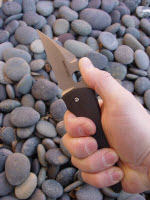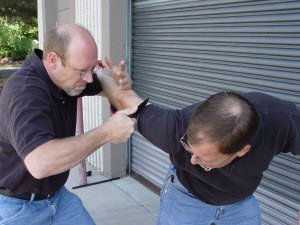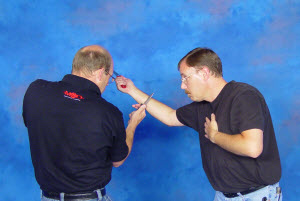 Self-defense is all about stopping power. Regardless of the weapon you use, your ultimate goal is to efficiently and decisively stop your attacker from carrying out his attack. And the less capable the weapon you use, the more skilled you need to be in its application.
Self-defense is all about stopping power. Regardless of the weapon you use, your ultimate goal is to efficiently and decisively stop your attacker from carrying out his attack. And the less capable the weapon you use, the more skilled you need to be in its application.
In previous PDN articles, I’ve discussed the realities of using a knife as a personal-defense weapon and the Martial Blade Concepts (MBC) approach to achieving decisive stopping power with a blade. In simple terms, you must accept the fact that the knife you will be using will be a small, legally permissible blade. You must also accept that using a small blade to target your attacker’s torso or neck to disable him through blood loss, shock, or damage to vital organs is a slow, indirect, and extremely inefficient approach that leaves you exposed to danger for an unacceptably long period of time. The quickest and most efficient way to stop your attacker with a knife is to stop the specific body parts that allow him to be dangerous to you. And you accomplish this by cutting the structures that instantly disable those body parts, like muscles, tendons, and nerves.
With all that in mind, one of the next steps in your training should be to develop an understanding of cutting dynamics and develop the skills to maximize the damage you inflict with every cut. That’s the focus of this article.
Simple Semantics
First of all, let’s establish some frames of reference. What we’re talking about is cutting specific tissues of the human body and any clothing that covers them with the highest degree of mechanical efficiency. As such, we’re going to stick with the term “cut.” Although some knife systems insist on overcomplicating things by differentiating between a “slash,” a “chop,” a “hack,” and whatever other contrived terms they might use, we’re going to keep it simple. We cut.
When it comes to cutting, there are two basic physical possibilities: One is that the blade is in motion before it strikes the target and it continues in motion as it cuts. The other is that the blade is placed against the target first and then moved to generate the cutting force. I refer to the first method as ballistic cutting and the second method as pressure cutting.
The Basics
The best way to understand the basic dynamics of combative cutting is to think of cutting a steak or similar piece of meat. It’s also the best way to grasp the concept of pressure cutting, since ballistic cutting doesn’t lend itself well to fine dining. Using your fork to stabilize the steak, you place the edge of your knife against the meat and do two things: you move the cutting edge back and forth while you apply downward pressure. These two actions are the key components of an effective cut with a small knife. If both are not present, you either don’t cut at all or you work much harder than necessary to get the job done.
When it comes to combative cutting, the exact same principles apply. The cutting edge of a knife is basically a microscopic saw. Drawing that edge through the target allows it to work most efficiently. The longer the cutting edge is and the longer it is in contact with the target, the deeper the cut it will produce.
Pressure into the target is also important. If you place the cutting edge on the meat and press straight down, a sharp knife will still cut. However, in that application, the edge is working more like a wood chisel or a wedge than a knife, and the amount of pressure required to cut is excessive. Against “compressible” targets like clothing-covered flesh, it’s unlikely you’ll cause any damage this way. If you apply pressure and then move the cutting edge longitudinally through the target, you’ll be rewarded with a deep, efficient cut. And the first step to doing this reliably and consistently is with a proper grip.
Get a Grip
If you do any research on knife tactics, you’ll find references to many different styles of knife grip. You’ll also get some creative explanations as to why a particular grip is the only method you should use, whereas others are guaranteed to get you killed in a critical incident. If we maintain our focus on the mechanics of cutting, the requirements of a proper grip become very clear.
Again, let’s accept that we’re using a short-bladed knife because it’s legal to carry. Let’s also assume that we’re talking about a ballistic cut that needs to be performed during a very brief window of opportunity. To visualize this, imagine that you’re cutting the flexor tendons on the inside of an attacker’s wrist as he swings a tire iron at your head. To cut those tendons or the forearm muscles that power them effectively, you need to make the most of the short cutting edge of your knife by drawing the entire length of the edge through the target. That means that you must first make contact with the “heel” of the edge—where the cutting edge starts closest to the knife’s handle. The easiest way to do that is by using a natural index: your thumb.

A proper grip places the thumb immediately opposite the heel of the cutting edge and angles the blade at about 135 degrees to the forearm. By guiding the blade with the thumb and maintaining the wrist angle, you cut with the entire length of the edge and maintain pressure into the target throughout the cut.
www.personaldefensenetwork.comThe other component of an efficient cut—constant pressure into the target—also begins with a proper grip. Beginning with the grip described above, extend your arm and imagine touching something with the ball of your thumb. Freeze your wrist in that position and take a look at the natural angle between your wrist and the blade of the knife. You’ll find that your wrist instinctively settles to an angle of about 135 degrees (45 degrees forward of a vertical plane).
Combined Dynamics
For easy reference, let’s now imagine a vertical cut. If visualizing a target helps, imagine your attacker’s forearm extended horizontally in front of you. Begin with your knife gripped as described above. Pick a spot on the arm and aim at it with your thumb. Your arm will naturally extend, unfolding at the elbow until the heel of the blade makes contact with the target, guided by the thumb just above it. At that point of contact, the angle between your wrist and the blade is a natural 135 degrees or so, meaning that the point of the blade is extending forward at about 45 degrees.
If you now continue the motion of your arm, you will draw the entire length of the cutting edge through the target. As you do, the natural forward angle of the blade will maintain a constant pressure into the target. The resultant synergy of these two dynamics combines the longitudinal motion of the cutting edge with optimal pressure into the target to produce a deep, extremely efficient cut.
The Pressure is On
Although critics of structural targeting with knives are fond of claiming that it requires “surgical precision,” as we can see from the above example, that’s just not the case. If a surgeon considered a margin of error of roughly six inches in either direction acceptable, I wouldn’t want to be his patient!
With that said, sometimes the best way to get the cut you need to stop an attacker is to first control the target and then place the blade. By achieving accuracy before you worry about power, you increase your chances of cutting the parts that matter most. To illustrate this, let’s revisit the tire-iron scenario.

A pressure cut is performed by first stabilizing the target, placing the blade accurately, and then applying pressure to create the cut. Here it is demonstrated against the triceps muscle.
From this position, stiffen your wrist to maintain its structure, anchor your right elbow tight against your ribs, and bend your knees suddenly to drop your entire body weight on the edge of your knife. This is a textbook example of what I consider a pressure cut—placing the blade on the target and then applying pressure. Since the blade is pre-positioned at a 45-degree angle, the downward pressure of your body dropping creates a shearing effect that combines constant pressure on the edge with longitudinal movement of the edge through the target. The power and wounding potential of this cutting method are devastating.
We’re Just Getting Started
The dynamics of cutting—particularly with small knives—must be understood and mastered to make the most of your edged-weapon tactics. Without such an understanding, you’re literally “going through the motions” without realizing the full potential of your cuts. Because of the importance of this topic, I will explore it further in future PDN articles.


Yeah, a strike to the neck will disable and drop them in seconds and death is closely followed. Try youtube. Happens in England all the time. It is fast and lethal and there is zero threat after the gash. Just a dead man dropping.
Awesome information. Thank you for the info.
What if you are a lefty and looking at an angle 1 attack ?
I would like more info on theses tactics
You've convinced me! I used to think that the best knife grip for my was to grip it backwards with the back of the blade against the right side of the wrist of my right hand. This would allow me to use my fist for punching and still be able to deliver a backward cut. From now on I shall practice with the knife hold presented in this article.
this is a perfectly timed article . as i will be in the great maple leaf in the next few days and the only weapon you may carry is a small pen knife undoubtedly i am going to be looking for a serrated blade with a good solid grip and this helps greatly :)